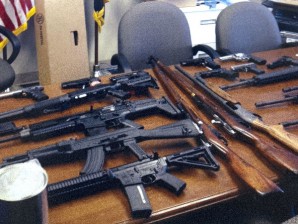WASHINGTON — The horrific shooting that has left 20 young children and six adults dead in rural Connecticut revived the familiar US gun law debate, where restrictions vary widely between different states.
And even the federal government regulates “very, very little,” noted Robyn Thomas, executive director of the Law Center to Prevent Gun Violence.
Almost all the injuries were fatal at Sandy Hook Elementary School on Friday in the small town of Newtown, indicating that once targeted, there was rarely any chance of escape, and that the gunman was unusually accurate or methodical in his fire.
The so-called Brady law, signed into law by president Bill Clinton in 1993, requires federal background checks on firearm purchasers in the United States. It is intended to detect any potential red flags in an individual’s criminal and mental health history.
But 40 percent of arms sales are not affected by the law, because they take place between private individuals, including through websites, or at gun show stands. Such sales are not regulated by the federal government.
The law concerns only federally licensed dealers, manufacturers or importers, with a few exceptions.
And the National Instant Criminal Background Check System maintained by the FBI has its own loopholes.
Mayors Against Illegal Guns — an organization of city mayors seeking tougher federal, state and local gun regulation — found that millions of files on people with mental health issues were not included in the database.
US media reported that the shooter, believed to be Adam Lanza, 20, had a history of mental illness.
And although the two handguns and semi-automatic rifle found at the scene appeared to be legally purchased by his mother, advocates said a more exhaustive database could help prevent people like Lanza from obtaining such weapons.
In another example, Jared Loughner, who killed six people and seriously wounded then-representative Gabrielle Giffords in Arizona in January 2011, obtained the greenlight from the background check system before purchasing his guns.
Loughner was cleared even though he was suspended from school for misconduct and had a history of drug use.
Attempts to track gun purchases are further complicated by the long borders the US shares with Canada to the north and, especially, with Mexico to the south.
Even within the 50 US states, the variations in gun laws can make it easier for people to evade restrictions.
Thirteen states do not consult background checks compiled outside the vendors’ state. Any criminal history in another state or at the federal level would thus be left out.
“Because our borders are porous, even if a state has very strict laws, it’s usually very easy to go to another state to get guns,” Thomas explained.
Most laws restricting gun sales take place at the state level.
California has the most restrictions, with federal background checks on all gun sales, even private ones. Assault weapons and sniper rifles are also banned and buyers can only purchase one gun per month.
Buyers must also first obtain a Handgun Safety Certificate, which requires them to take and pass a written test on handgun safety.
Thomas credits the measures with a “big reduction” in gun violence over the past 20 years in California.
In Connecticut, where Friday’s shooting took place, there is a ban on owning or transferring assault weapons, such as the Bushmaster .223 M4 carbine rifle found on the scene, according to The New York Times.
The other two weapons used by the shooter, a Glock pistol and a Sig Sauer rifle, both require a certificate before being purchased.
From 1994 to 2004, a federal law banned the production and sale of assault weapons, but Congress failed to renew the text.
And the very definition of assault weapons is a matter of debate.
California, for example, lists certain characteristics, such as a stabilizer and high-capacity magazines that allow the guns to rapidly fire multiple rounds.
But manufacturers “will always try and find ways around it,” Thomas warned.
